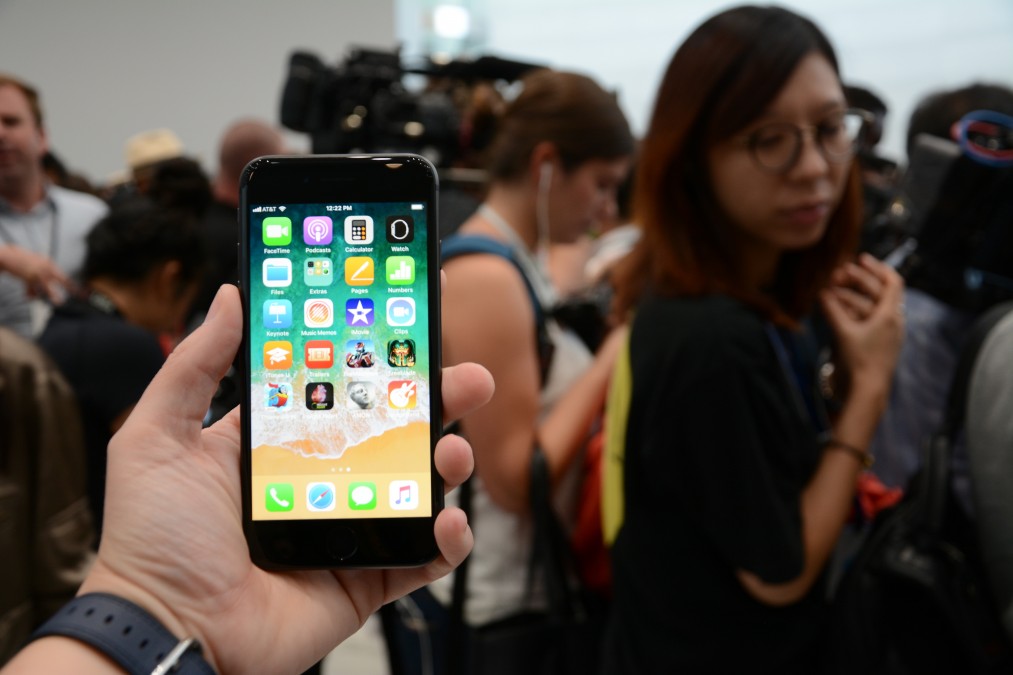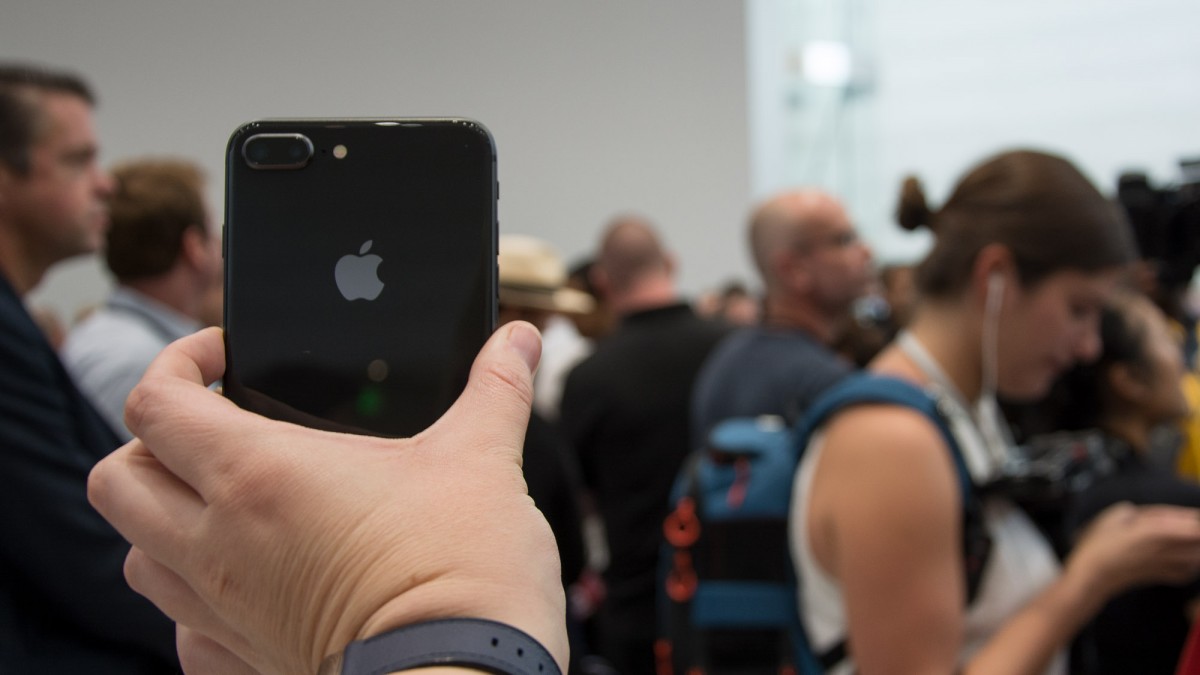iPhone 8 Plus hands on: Apple makes its latest phablet look positively cheap against the iPhone X
The iPhone 8 Plus offers a number of improvements that elevate it above its predecessors

You typically have to wait a year for the latest Apple iPhone to be surpassed, yet at its most recent launch event, this took just ten minutes.
Fresh off the back of unveiling the iPhone 8 and iPhone 8 Plus, Apple launched its flagship iPhone X -- a high-end model that completely redesigns how the iPhone looks and works, leaving the iPhone 8 range looking almost second-rate.
It's not though, and both the iPhone 8 and iPhone 8 Plus have a number of improvements that elevate them above their predecessors without the eye-watering price of the iPhone X. In this hands on, we reveal our first impressions of the larger of the two phones -- the 5.5in iPhone 8 Plus.
iPhone 8 Plus review: Key specifications and release date
| Screen | 5.5in, IPS display, 1,920 x 1,080 resolution, True Tone technology |
| CPU | 64-bit 6-core Apple A11 Bionic processor with M11 co-processor and "Neural engine" |
| Storage | 64GB or 256GB storage |
| Camera | Dual 12MP f/1.8 and f/2.8 rear-facing camera, both with OIS and sapphire crystal lens cover; 7MP, f/2.2 front-facing camera |
| Software | iOS 11 |
| Price | Price: 799 (64GB); 949 (256GB) |
| Other | Wireless charging, No 3.5mm headphone jack, Dust- and water-resistant to IP67 |
| Pre-orders | 15 September |
| Release Date | Release date: 22 September |
iPhone 8 Plus review: Design, key features, and first impressions
The iPhone 8 Plus comes with design improvements, a more powerful processor inspired by the human brain, wireless charging and improved cameras, all designed to tempt you into upgrading, or even switching from Android.
Its 12-megapixel rear-facing camera, for example, features a faster and larger sensor which Apple claims "delivers advanced pixel processing" and "faster autofocus in low light. The rear of the iPhone 8 is now made from reinforced glass, signaling a significant move away from the metal design of the iPhone 7 range, while giving a nod to the original iPhone from 2007. Beneath this glass panel is a wireless charging panel for the first time meaning the iPhone 8 Plus can be charged on any Qi standard charging plate. Apple joined the Wireless Power Consortium in February, at which point rumours of the iPhone 8 featuring wireless capabilities began to circulate. Apple, of course, already offers a wireless charging option with the Apple Watch, although that is powered by MagSafe technology rather than Qi.
Not only did Apple confirm the wireless charging rumours, it also took a step further by unveiling its own charging mat, the Apple AirPower. It's not due to be released until 2018, and the price is unknown, but the AirPower will allow three devices to charge at the same time using inductive and resonance charging.
A brief glimpse at the AirPower showed an iPhone 8, the Apple Watch 3 and AirPods charging at the same time. This revealed that the Apple Watch 3 is moving away from MagSafe (RIP the MagSafe dock) and suggests a new AirPods case is coming, as the current one doesn't support wireless charging.
Get the ITPro daily newsletter
Sign up today and you will receive a free copy of our Future Focus 2025 report - the leading guidance on AI, cybersecurity and other IT challenges as per 700+ senior executives

Its 5.5in display uses so-called True Tone technology to make the screen blend in more with its surroundings, giving it a more natural appearance, and the iPhone 8 Plus - like the iPhone 8 and iPhone X - runs on Apple's neural networks, powered by its new A11 Bionic chip. The iPhone 8 Plus has also been "custom tuned" for the augmented reality features built into iOS 11.
Before getting an iPhone 7 Plus, I never thought I liked larger screens. Having spent a year with it, I now can't use smaller models so the iPhone 8 Plus remains a familiar-sized handset. The larger form factor, compared to the iPhone 8, and the glass back make the phone feel extremely high-end, and the screen's size highlights the improvements that have been made to this display (namely the addition of True Tone and the Retina Display) much more than on the smaller iPhone 8. This larger display additionally helps showcase the ARKit features more effectively.
Beyond the screen, the Portrait Mode introduced on the iPhone 7 Plus now comes with Portrait Lighting on the iPhone 8 Plus. You can mimic the kind of lighting effects created in professional studios, as well as stage lighting, and the results are seriously impressive.
"Portrait Lighting is based on extensive research into the art and science of portraiture and core photographic lighting principles," Apple explains, and it uses the dual cameras as well as an image signal processor to recognise the scene, create a so-called depth map and separate the subject from the background. Machine learning is then used to create "facial landmarks and add lighting over contours of the face" in real time.
iPhone 8 Plus review: Early verdict
Like-for-like, the iPhone 8 Plus offers enough improvements to warrant an upgrade from the iPhone 7 Plus. An upgrade is especially warranted if you have the smaller iPhone 7 or previous iPhone models.
The new glass design on the iPhone 8 range is a genuine delight, and its AR capabilities really do need to be seen to be believed. Having wireless charging is now a significant selling point for the iPhone 8 Plus, as well as the iPhone 8, and the more powerful, AI-based A11 Bionic chip feels like it's worth the investment. It's also cheaper than the Samsung Galaxy Note 8 -- 799 vs the Note 8's 869.
That said, the Samsung Galaxy Note 8 does come with expandable storage and has an edge-to-edge display akin to the iPhone X. Google's introduction of ARCore will see more Android devices taking advantage of augmented reality, and it already features wireless charging.
If you're looking to stick with iOS, or make the move to it, the iPhone 8 Plus is our favourite in terms of features and (relative) value for money from the three phones announced at Apple's September event. It's still an incredibly expensive handset, but on the right pay-monthly package, it could prove a worthwhile treat.
Image source: Victoria Woollaston
-
 Cleo attack victim list grows as Hertz confirms customer data stolen
Cleo attack victim list grows as Hertz confirms customer data stolenNews Hertz has confirmed it suffered a data breach as a result of the Cleo zero-day vulnerability in late 2024, with the car rental giant warning that customer data was stolen.
By Ross Kelly
-
 Lateral moves in tech: Why leaders should support employee mobility
Lateral moves in tech: Why leaders should support employee mobilityIn-depth Encouraging staff to switch roles can have long-term benefits for skills in the tech sector
By Keri Allan